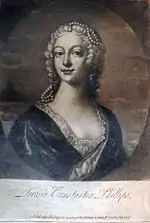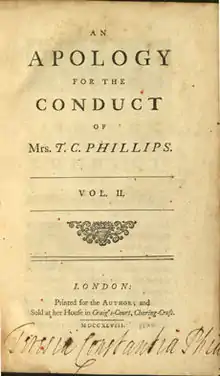Teresia Constantia Phillips
Teresia Constantia Phillips or Con Phillips (2 January 1709 – 2 February 1765) was a British courtesan and bigamist who published a scandalous autobiography.[1]
Teresia Constantia Phillips | |
|---|---|
 | |
| Born | 2 January 1709 Chester, England |
| Died | 2 February 1765 (aged 56) Kingston, Jamaica |
| Nationality | British |
| Other names | Con Phillips |
Life
Phillips was born in Chester in 1709. Her early life is not reliably known as the major source is her autobiography. Her education was said to have been paid for by her godmother, Catherine Powlett, the Duchess of Bolton. She attended Mrs Filler's boarding-school in Westminster until her father remarried to a servant. It has been suggested that the choice of step-mother may have led to her godmother removing the source of funding. She was raped at the age of 12 or 13 (or 15[2]) by a character known as "Thomas Grimes". This was thought to be the assumed name of Philip Stanhope, 4th Earl of Chesterfield, but more recent research identifies her attacker as Thomas Lumley-Saunderson, 3rd Earl of Scarbrough. Phillips herself never realised who her attacker was and intriguingly her autobiography was dedicated to the man who attacked her, the 3rd Earl of Scarborough.[3]

Courtesan
In November 1722 she married a bigamist at the Anglican church of St Benet's, Paul's Wharf. This man assumed responsibility for her debts. Less than two years later she married at the same church a rich merchant called Henry Muilman in February 1724. The marriage did not last long. It has been speculated that the marriage was ended after her past was discovered.[3] Muilman refused to pay her the money that had been agreed as part of the separation and a dispute began.[2] During the long court case she was said to have had seven other affairs. The men involved included her surgeon and the Tory M.P. Sir Herbert Pakington, 5th Baronet.[3] In 1727 she began a relationship with the gardener Philip Southcote.[4]

Phillips went abroad to France a number of times to avoid her creditors, but this was not always successful and she served time in the debtors' prison from 1742 to 1744.[3] The long-running court case between her and Muilman was settled in 1748.[5]
Memoirs
Phillips wrote scandalous memoirs which had thinly hidden descriptions of her liaisons. Her main work was An Apology which was published in eighteen parts making up three volumes from 1748 through to 1749.[6] Michael Mascuch notes that the tone changes from a self-effacing apology to a proud justification for her victory over adversity and ill treatment.[2] These potentially libellous works led to Henry Fielding casting "Mrs Fllps" as a whore in a puppet play he wrote and he later urged the full force of the law of libel to be used against people like her and Paul Whitehead. Whitehead was presumed to be her accomplice in her publications.[7]
Phillips' descriptions were not always complimentary as she made out Philip Southcote to be self-obsessed and effeminate. The books themselves were so scandalous that the academic, Elizabeth Carter's, reading was described as so charitable that it would allow "her to read sympathetically even the scandalous memoirs of Teresia Constantia Phillips". It has been speculated that the books may have been published in serial form to encourage blackmail of her previous lovers.[8] The book described her five marriages and affairs with seven well-known men and the double standards that applied to her own life and bigamy.[5]
Jamaica
In 1751, Teresia Constantia Phillips settled in Jamaica with her lover, the wealthy Clarendon planter Henry Needham. Upon the instigation of Needham's friend, governor Henry Moore, she became singular as the only woman to be given an official government post when she was appointed by the governor with the office Mistress of the Revels, an office with the task to supervise and organize the official celebrations and entertainments in the colony, a task she performed and for which she was given a salary from the government.[9]
Phillips died in Kingston in Jamaica. She was said to have made three additional marriages in Jamaica and she was said to have died without mourners.[3]
References
| Wikimedia Commons has media related to Teresia Constantia Phillips. |
- PointingFingers, Brynmawr.edu, retrieved 25 March 2015
- Mascuch, Michael (2013). The Origins of the Individualist Self. pp. 290, 293, 294, 322, 331, 332–3, 352–3, 355. ISBN 978-0745667737.
- Emma Plaskitt, 'Phillips , Teresia Constantia (1709–1765)', Oxford Dictionary of National Biography, Oxford University Press, 2004 accessed 1 April 2015 (subscription is required)
- John Martin, 'Southcote, Philip (1697/8–1758)', Oxford Dictionary of National Biography, Oxford University Press, 2004 accessed 1 April 2015 (subscription is required)
- Stone, Lawrence (1992). Uncertain unions : marriage in England 1660-1753 (Repr. ed.). Oxford: Oxford University Press. ISBN 9780198202530.
- Spedding, Patrick. The Publication of Teresia Constantia Phillips's Apology (1748–49) [online]. Script & Print, Vol. 35, No. 1, Apr 2011: 23–64. Availability: here, ISSN 1834-9013. [cited 27 Mar 15]
- Battestin, Martin C. (2000). A Henry Fielding companion ([Online-Ausg.] ed.). Westport, Conn.: Greenwood Press. p. 115. ISBN 031329707X.
- Elizabeth Carter, UK Red, retrieved March 2015
- Trevor Burnard & John Garrigus: The Plantation Machine: Atlantic Capitalism in French Saint-Domingue